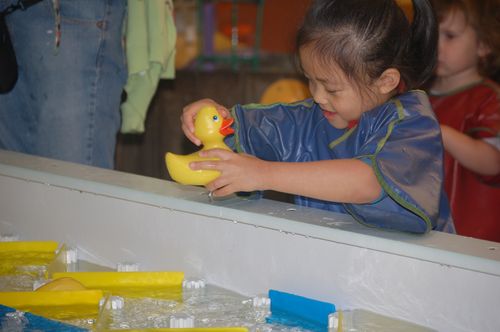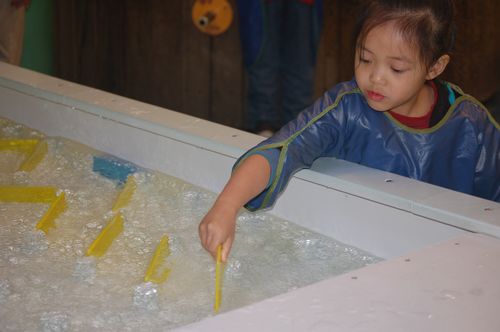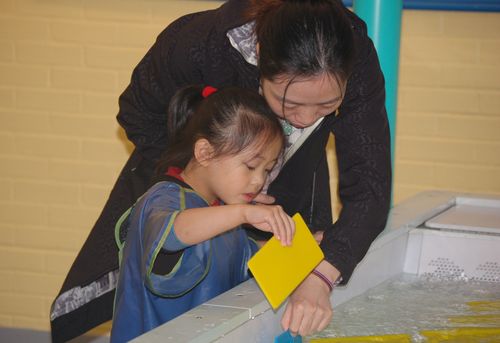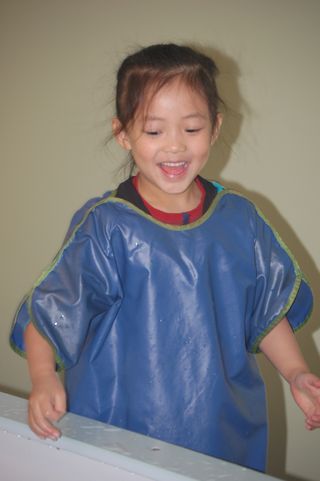What is Playful Inquiry?

Remember the feeling of your own childhood play– when time disappeared. An hour went by in what felt like seconds because you were lost in your play, alert and alive in your wonderful ideas.
These play memories are powerful for most adults, and result from the deep and lasting learning that occurred within that play. In your play, you figured something out, worked something out, imagined something new, tested your own limits, connected with others, and likely experienced moments of unbridled joy.
Playful inquiry invites children to learn and make sense of the things they encounter with the kind of curiosity and joy we remember from our happiest moments in childhood.
From the time they are born, children are avid seekers of meaning and relationships who explore the world using all of their senses. Babies, like scientists, are some of the best learners in the universe (see The Scientist in the Crib by Gopnik, Meltzoff and Kuhl). Children have at their disposal myriad natural abilities such as noticing patterns, telling stories, tinkering, wondering and imagining. They come into the world pre-wired with these tools, and driven to use them to learn and to understand what's around them.
Rich in sensory detail, and intellectually rigorous, experiences in playful inquiry wire the brain with strong, complex pathways, while encouraging children to become lost in the power of play. This state of play relaxes the mind, but also keeps it highly challenged and engaged. Our most optimal state for learning occurs during playful inquiry.
Watch this video. What are you drawn to? What does it tell you about the role of play in learning? What does it tell you about your work with children? We're looking forward to reading your reflections and questions in the comments field below or the discussion forum.





“Playful inquiry invites children to learn and make sense of the things they encounter with the kind of curiosity and joy we remember from our happiest moments in childhood.”
As a teacher, I strive for these moments in my classroom, moments where the children are engaged and full of curiosity and joy. Whether it with materials, spaces in the classroom and even each other, I enjoy watching these moments happen when the children get lost in their “work.”
Some things that I wonder when thinking about playful inquiry:
* What importance does the environment play in playful inquiry?
* What is the role of the adult?
* What is the role of documentation?
And to the overall online community, what does “playful inquiry” mean to you? What does it look like in your classroom community?
I would really love to continue this conversation with different insights from fellow teachers!
-Nicole Simpson-Tanner, Opal Museum School – Early Kindergarten
I don’t have a class of my own, but I see 2 pre-K classes and 3 Kindergarten classes four or five times a week each for scheduled music and art. During art times the children can choose to explore different materials. I hope they will engage in playful inquiry but don’t always achieve this! I think the way materials are presented is crucial; from the way they are set out on a table to what the teacher chooses to say (or not say) but am continually surprised by how often you cannot predict which materials will encourage playful inquiry (and it changes from group to group!) So I think the environment is important but the characteristics and dynamics of the group and individuals within the group also play a part and obviously the relationship the children have with the adults in the room.
I love the term “playful inquiry”. In our school we have been struggling to find a term that accurately captures this type of open inquiry.
I think one of the critical factors for children to be able to engage in playful inquiry is the role of the teacher. We need to live in the tension, listening and watching carefully. We must harness our impulse to step in and help too soon, to give the child time to trial and experiment. It takes time to become more comfortable with living in the tension, the unknowing of where the child’s inquiry may take them and how we can support it.
I work with infants and I really love how I am basically able to sit back and let the children learn, allow them to take risk’s, explore there voices, to reach for something so close but yet to them so far because they cant crawl but to watch them grow the muscles and strength to help there body’s grow and reach that toy another day is an amazing process for the younger ones.
ps, I know it is way late but this is life of a mom of three 🙂 When they are sleeping is the only time to focus
The time that I am most engaged in play is when I am drawing or painting. The creative act requires time and often we don’t give children the time they need to become immersed in play for whatever reason: scheduling, adult needs to move quickly from tasks to task. How can we give children the time they need (not to mention ourselves) and also help them cope with having to let it go?
I think this article, and the term “playful inquiry” begins to move us forward to being able to completely reclaim play for play’s sake. Not play as work (an adult value) or even play as learning (it happens BECAUSE of play) but to truly “crack open” (love this concept!) PLAY! Joy, wonder, inquiry, magical surprise, imagination, investigation, engagement, connection…truly being a full human being in the world. I’m excited to keep reading (articles and comments both)!
For me, the success with playful inquiry is a philosophical commitment to it and that your practice transcends this belief. Playful inquiry won’t happen on a Friday afternoon once a week, it is a stance that underpins all curricular decisions. I also don’t think it happens by chance. Our role is to plan for it through choice of material and provocations in the classroom. We also need to be present and ready to facilitate the children’s needs and support the next step in their inquiry.
Watching the children engaged in “free play” in the video clip I noticed the role of the “props”. The props seem to ask the questions, invite the investigations. In such a rich environment the props and material move the free play towards playful inquiry. How do I bring this richness into my environment? How do I ask the questions to move the thinking forward with out interrupting the joy? I am challenged by limited resources, but have seen how just a box of scarves, fabric pieces create an opportunity for children to create a world for imaginative play.
As I observed the delightful play environments in this video, I, too, wanted to jump in and be a kid! Certainly not all play environments have to be on a grand scale, but watching this made me appreciate the magic for children of being able to fill a whole table (or tables) with an ever developing clay environment, for example. To share stories and make whole worlds! I love those collaborative explorations. I ‘m also reflecting on the recurring description of play making time seem to disappear. I hope that holding that thought will help me be a more mindful teacher at transitions, which my program keeps as flexible as possible, but which nevertheless do interrupt some of the focused play.
Thanks for posting your response, Gail!
I think that connecting to our own need for play in our lives – both remembering it from our childhoods as well as living it as adults – allows us to value it and advocate for its continued role in our formal learning environments.
Looking forward to hearing more from you!
Matt
I am lucky to have a shared space into which we are free to provide any provocation we choose. However, and it is a BIG however, we are increasingly being held accountable to packaged programs; Words Their Way, Writing Pathways, Investigations into Maths, Handwriting Without Tears, the Daily 5, Delta Science, Second Steps. My challenge is how to provide opportunities and provocations for insightful playful inquiry, without it being perceived as ‘just play’. As I have a class of 20, I have found it helps me to have different structures set up throughout the day, to bring the children together as a community, teach in small groups, then release to play. However, the amount of time I would need to deliver all these programs to small group teaching is just not enough. They are only Kindergarteners and I sometimes feel so cruel having them all sit for whole group instruction, but could I honestly filter hose who I felt were ‘ready’ for teaching? Play for play’s sake has been inspirational when the design and space has provided great opportunities for learning, but it frustrates me because ‘creativity’, ‘curiosity’ and ‘inquiry’ are part of our school vision, but not part of our program….I will be excited to hear more of how people manage the external pressures from administrators and parents, as well as colleagues, to ‘get to the job of teaching them to read and write’. So
I was excited when one of the resource teachers (Ruslana, on this course) was able to deliver a phonic program, and provide what I called a ‘cascade’, the first child would gain experience and confidence in one phonic lesson, then build their role as ‘leader’ in teaching the next child, the 10 minutes we had told him he became 20, and then the two are free to go and explore in the luxurious spaces we have. Then two more girls, both displaying different learning challenges, carry on with the cascade, and again, are free to release into creative inquiry. The boys have built a ‘slide’ out of blocks, which has become a favourite with the other children. The girls recreated paper ‘computers’, stories, puppet shows….meanwhile I am managing the other 15 at their seats, having them go through phonic repetition, craft, reproduction and it just feels wrong……this module may change their lives and mine irreversibly…..hope I don’t get fired! 🙂